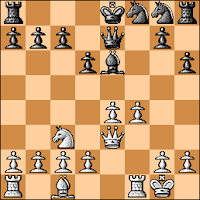In my most recent Jerome Gambit game, in a line that I was familiar with, I nonetheless ran out of ideas. Lucky for me, I was able to keep making scary moves - enough for my opponent to overstep his clock (we were playing 2 12).
perrypawnpusher - RcSm
2 12 blitz, FICS, 2017
1.e4 e5 2.Nf3 Nc6 3.Bc4 h6
The Semi-Italian Opening.
4.O-O Bc5
After the game I was surprised to discover that I had played three games previously against RcSm. Interestingly enough, none were Jerome Gambits. One game continued 4...Nf6 5.Nc3 d6 - perrypawnpusher - RcSm, 2 12 blitz, FICS, 2012 (0-1, 30) - and two continued 4...d6 - perrypawnpusher - RcSm, 2 12 blitz, FICS, 2013 (1-0, 30) and perrypawnpusher - RcSm, 2 12 blitz, FICS, 2014 (1-0, 41).
5.Bxf7+
The Semi-Italian Jerome Gambit.
5...Kxf7 6.Nxe5+ Nxe5 7.Qh5+ Ng6
Before this game I was 19 - 2 - 2 in games with this position, according to The Database. That's 87% - and one of those losses came after the mouse slip 8.Qe5??
8.Qd5+ Ke8 9.Qxc5 d6 10.Qe3 Qe7
This is a reasonable move, although there are only 2 other games in The Database with it. White is going to want his Knight to come to c3, and maybe later to d5, harassing the Queen. A pawn advance to f4 (and later, further) and one to d4 also seem relevant.
11.Nc3 Be6
In analyzing the game post mortem I was intrigued by Stockfish 8's suggestion that, instead, Black should castle-by-hand on the Queenside: 11...Kd8 12.f4 Bd7 13.b3 Kc8 with an equal game.
My opponent eventually did do something like that in this game, but it did not wind up as strong.
The text encourages my next move, which I guess came as a surprise to my opponent, as he first retreated his Bishop, then later advanced it to c4 - something he could have done right away.
12.f4 Bf7
An earlier game of mine continued 12...Nf8 13.f5 Bc4 14.d3 Bb5 15.Nxb5 Qd7 16.Nc3 g6 17.Bd2 Kd8 18.d4 Nf6 19.e5 dxe5 20.dxe5 Nd5 21.Nxd5 Qxd5 22.Bc3 Rg8 23.Rad1 Black resigned, perrypawnpusher - Macgregr, blitz, FICS, 2010.
13.d4 Kd8
Here he goes.
14.f5 Nf8 15.e5 Bc4
A cold-blooded alternative for Black is 15...Nf6, as after 16.exf6 Qxe3+ 17.Bxe3 gxf6 White's possibilities for attack have diminished with the exchange of Queens. He would be down a pawn, although the chances of creeping toward a drawn Bishops-of-opposite-colors endgame would be there.
A more refined way of implementing the Queen swap (leading to a better pawn structure) is 15...Nd7 16.e6 Nb6 17.exf7 Qxe3+ 18.Bxe3 Nf6 and White's pawn on f7 will fall.
16.Re1 Kc8
"Come and get me, Copper!" My opponent pulls a James Cagney and challenges me to show that I have compensation for the sacrificed piece.
17.Qg3 Kb8
After the game Stockfish 8 suggested that in this position I had the equivalent of a Queen advantage. Can you see that much compensation, here? During the game I was still trying to get my sacrificed piece back.
18.exd6
This much is pretty clear to figure out, even with the time on my own clock ticking away...
18...Qd7 19.dxc7+ Kc8
And now, what?
After the game, Stockfish 8 recommended 20.Ne4 (threatening the fork at d6) Bd5 21.Nc5 Qf7 22.Qd6 Nd7 23.Nxd7 Nf6 24.Nxf6 Bc6 25.Ne4, a line that I could not have imagined - White's Knight just marches in, captures two pieces, and leaves.
20.b3 Bf7
And now, what?
It is probably easier for you to see that - especially with Black's time slipping away - the idea is now for White to grab the pawn at g7, threaten the Black Rook, and let the defender do the thinking...
21.d5
During the game I figured out that now 21...Bxd5 22.Nxd5 Qxd5 23.Re8+ had to be crushing, so the pawn was safe. Also, 21...Qxc7 could be answered by 22.Bf4, and again Black would have to do the figuring.
In figuring I could simply march this pawn to d6 to protect the one at c7, I simply overlooked 21.Qxg7.
21...Nf6 22.Ba3
A tactical idea! Abandoning the idea of d5-d6, which would have been playable, e.g. 22.d6 Qc6 23.Re7 Bh5 24.Bf4 N8d7 25.Qxg7.
Still, after the game Stockfish 8 preferred 22.Qxg7 Rg8 23.Qxf6
22...Rg8
I would have been thrilled to follow the line 22...Qxc7 23.Qxc7+ Kxc7 24.Re7+ N8d7 25. Rxf7 when White's three extra pawns would be enough, in a calm and relatively simple position.
23.Re7 Nh5
Quick! I threaten his Queen, he threatens mine.
24.Qe3
Black forfeited on time
Black's Queen can only escape danger with 24...Qxf5, when I would have played 25.Re8+ Bxe8 26.Qxe8+ Kxc7 27.Qxa8 which would have satisfied me as I would have been up two pawns.
Stockfish 8 laughs at that assessment, proclaiming a checkmate in 24 moves from that position. It sees as best play 24...Nf6 25.Rxd7 N8xd7 and I can live with that, too.






























































